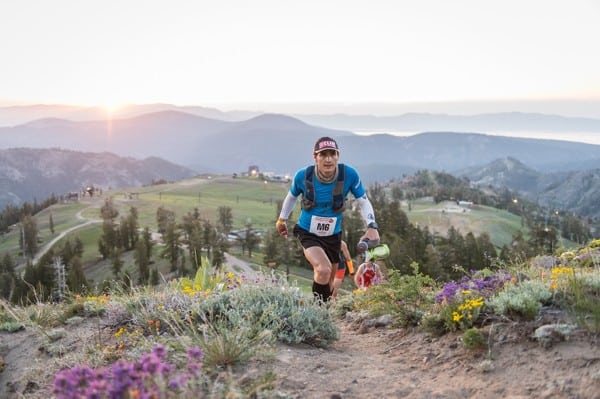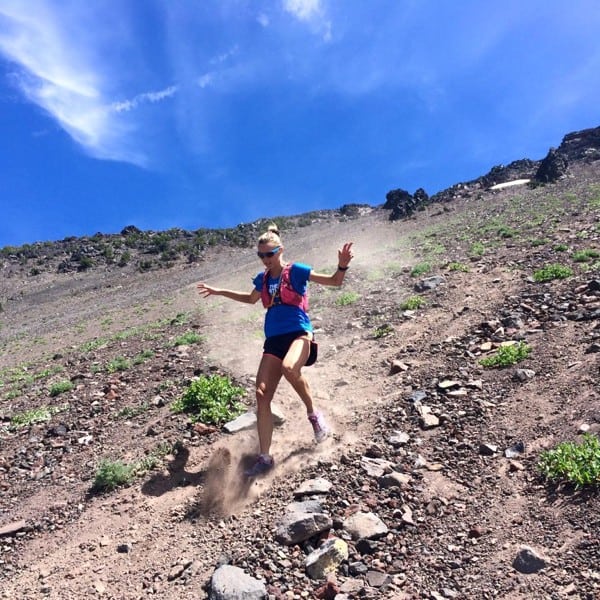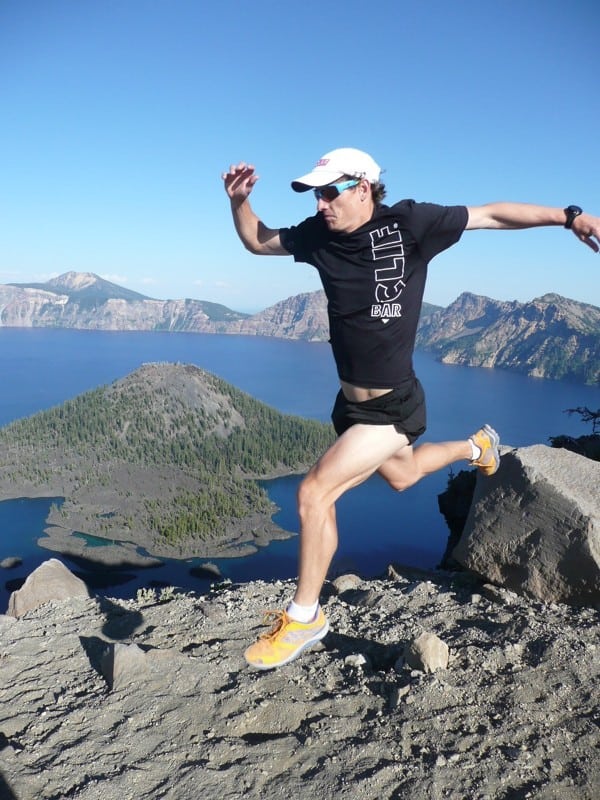 Competitive trail running is more than simply running hard on trails. Success requires a multifaceted skillset, ranging from terrain handling to temperature regulation, and from successful navigation to sustainable nutrition. The real beauty of trail running is that, of those myriad skillsets, few of them require innate, natural ability. This includes powering up and flying down hills. And so by developing these various skills, ambitious but less-gifted runners can hit the trails and compete against their more-talented peers at the highest level.
Competitive trail running is more than simply running hard on trails. Success requires a multifaceted skillset, ranging from terrain handling to temperature regulation, and from successful navigation to sustainable nutrition. The real beauty of trail running is that, of those myriad skillsets, few of them require innate, natural ability. This includes powering up and flying down hills. And so by developing these various skills, ambitious but less-gifted runners can hit the trails and compete against their more-talented peers at the highest level.
This phenomenon is not reserved for ultramarathons. It is alive and well even at conventional 8k and 12k cross-country-championship distances, so long as you throw in a few thousand feet of climb and descent, winding turns, thin air, and some dusty scree.
All were in abundance at the recent US Mountain Running Championships in Bend, Oregon. The circuit course, set against the base of Mount Bachelor Ski Resort, featured lung-sucking uphill grunts through a pathway of debris best resembling charcoal briquettes (mixed, of course, with expired charcoal dust) followed by sickeningly winding, screaming descents through singletrack and service road.
The top runners–six men and four women–who qualified for the upcoming World Mountain Running Championships have widely varied backgrounds (indeed, sixth and seventh places in the women’s race were 11 and 47 years old, respectively), but they all had one thing in common: they were phenomenal hill runners.
Proficient hill running, especially the lightning-fast descents seen at the mountain championships as well as top trail ultras, is a learned ability. Even the naturals like Kilian Jornet come from a downhill skiing and mountaineering background, where fast, fearless descents are honed early on.
It takes a combination of strength, agility, and–perhaps most of all–guts to be a great hill runner. Here are some tips gleaned from some of the best in ultrarunning.

The start of the 2015 US Mountain Running Championships women’s race. Photo: iRunFar/Bryon Powell
Powerhiking: It’s Not Just for the Back of the Pack
While taking in the men’s championship, I noticed ultra veteran, Grand Slam of Ultrarunning record holder, and six-time Western States top-10 finisher Ian Sharman flying uphill, holding his own in the chase pack. While hiking.
Into his final of three brutal up-and-down cycles, he was keeping pace in the championship the way he does best: powerhiking like a madman. Then, moments later, he was flying downhill into the finish.
Sharman is known for his furious powerhiking skills as well as his lightning descents. Besides being a top ultrarunner, Sharman also runs Sharman Ultra, a running-coaching service that helps scores of endurance athletes, mostly trail ultrarunners. After the race, I asked him how he models hill running–an integral part of most ultrarunning events–to his clients.
For ultras in particular, where the events take several hours or more, if there’s any question on hiking versus running, hike first. “For a given pace, hiking will be more efficient than running since it doesn’t involve lifting off the ground and bouncing. Therefore it uses less energy,” Sharman points out. The plyometric, bouncing nature of running will always take more energy than a simple hike, so the point at which running fails be faster, it’s best to hike.
The catch is, hiking must be practiced. While similar to uphill running, the muscles involved in a strong powerhike are used quite differently: strides are frequently longer and impulses–the force output per unit of time–are bigger. Even fast-footed hiking is a slower turnover than running. To the uninitiated, a powerhike can feel more exhausting.

Ian Sharman powerhiking during the 2015 Western States 100. Photo: Matt Trappe Photography
For any ultramarathon or trail event with heavy vertical, Sharman advises frequent, stand-alone powerhike workouts. Since the aerobic load is lower than running, they double as easy or recovery days.
His recent clients include Magdalena Boulet, who consulted Sharman in her preparation for the 2015 Western States, which she won. Although she possessed the fitness as a 2:26 marathoner, she recognized the unique challenges of the course, including the half-dozen major climbs and descents. Long Bay Area hikes up Mount Diablo and Tamalpais were central to her preparation, and crucial to her eventual victory in her first stab at the distance.
But what about running? Mellow upgrades, or short-but-steep grunts are even more common than major climbs. The strategic running of these inclines can help many kinds of runners break open a race, surpass a PR, or sneak in beneath a cut-off.
Strong, efficient hill running is, well, the same as flat running. It requires:
- A consistent forward trunk engagement (“leaning into the hill”);
- A quick, light cadence;
- A strong hip and knee drive; and
- A quick, powerful arm swing.
If a hill is short or mellow enough, a powerful, assertive stride will get you up and over a climb in short order.
But what if the hill is neither short nor mellow, then what?
Therein lies the art form. Sharman, again:
“Powerhiking can be quick, especially in an ultra, but knowing when to switch from running to hiking and back is a skill.” Like a video game, a hard-charging uphill run is like a turbo button: it is powerful, but finite. Running to the point of going into severe oxygen debt is a momentum killer, says Sharman: “It’s important not to run up to the point where walking is the only option, but instead strategically choose to hike at certain points.” Running to exhaustion makes it difficult to maintain any forward momentum, so paying attention to effort level–and switching to the hike before going completely anaerobic–is crucial.
Then, use the powerhike to maintain a respectable pace while recovering “the turbo”–or decreasing your heart rate–while the climb remains steep, or until the grade levels out. Sharman notes that on most steep grades, “a strong hiking pace can keep up with a weak running pace, which is what most runners resort to very early in races,” often because they aren’t efficient, experienced, or confident hikers.
But while races are often lost by running too aggressively up hills, few races are won by simply hiking. “There’s an upper limit on hiking pace which is lower than the running upper limit. For trail runners, both uphill hiking and uphill running need to be practiced frequently to learn how to get the most from each.“
Interestingly, while observing the front of both the men’s and women’s fields, the top runners hiked more than those in the chase pack. Presumably, they utilized a powerful, confident powerhike to rest and recover before switching back to an aggressive climbing gear.
And before they knew it, it was time to fly downhill.
“Controlled Chaos:” Making the Most of Major Descents
Elite downhill runners are not born, they’re made. The world’s best mountain runners may look like naturals, but their performances are the culmination of meticulous and voluminous practice.
While she wasn’t a presence at the mountain-running champs, Stephanie Howe has been at the front of every race she’s run for the past two years. But it’s taken work. She’s always been fit, and after putting in the work on her home trails outside Bend, Oregon–honing the craft of technical hill running–she’s now among the best all-round competitors in ultrarunning.
“I sure did work on my downhill running!” Howe is quick to point out. And, she admits, “I used to suck at it and was tired of having that be an excuse for getting passed. So I really worked on it for two years and now I feel it’s my strength. Moral of the story: it’s trainable.”
Central to her improvement–and subsequent rise to the top of the sport’s elite mountain runners–was a move to Bend, where she could have both the grounds and cohorts to hone the craft of efficient hill running.
Most of us have watched a proficient downhiller blast past us during a race. However, when it happens on training runs, one takes notice. Howe got a wake-up call when she began running with the many elite mountain runners living in the area. This included mountain descents with Ian Sharman. “I did run behind Ian a few times going down South Sister to get better, and I think running behind someone and trying to keep up with them for as long as possible can be helpful.”
After that, she began to make a habit of quick but efficient descending on every run. “To start, I made a point to really run down each hill, even on easy runs. It’s easy to get caught up in just running really easy downhill, particularly when running with friends. Instead of just mindlessly running downhill, I’d try to think about what I was doing. Quicker turnover, fast feet, using gravity. I wasn’t comfortable at first, but I stuck with it.”

Stephanie Howe practicing technical downhill running. Photo courtesy of Stephanie Howe.
Sharman echoed the sentiment that fast downhill running must be practiced, all the time. “For downhills, it’s very difficult to improve without practicing pushing beyond the comfort zone,” says Sharman. And for many runners who simply want to enjoy an easy run, the investment in a quick and often jarring descent has substantial cost.
Fast descents, especially early on, can feel exhausting. Muscles, nerves, and the brain, which must process incoming information at often overwhelming speeds, are working much harder and faster, so it’s not uncommon for a novice downhill runner to become more out of breath on a quick descent than a flat run at the same pace.
Quick descents can also create muscle soreness, and few runners wish to create more muscle stress on an easy run.
But both fatigue and soreness will dissipate over time when a runner commits to running every descent quickly and efficiently. The body becomes quicker and more responsive, and the muscles more resilient.
“Cadence is King:” Fast Turnover is Key to Downhill Success
Commitment to fast descending is step one, but efficiency is crucial. That’s where cadence–or steps per minute–comes in. Research on flat running has found that efficient distance running has 180 steps per minute, while sprinting is even higher: upwards of 200 to 240 steps per minute.
Fast, technical descending is often like a sprint, so a fast cadence is crucial for several reasons:
- Energy conservation. The faster a foot lands and then takes off, the less energy that leg absorbs. Energy that must be absorbed by a muscle takes effort and, over time, will exhaust that muscle. So while a mega-fast cadence may feel efforted, very little energy is absorbed by the muscle, and its integrity will be preserved.
- Control. The faster the foot lands, the less time is spent on the ground. Sharman points out that during a high-cadence technical descent, “if the foot lands on a rock that’s unstable, there’s no problem, because you’re off of it so quickly.” The opposite is true with a slow, lumbering cadence: you land and pound. Ironically, quick equals control.
Fast Descending is Fast Running!
Cadence goes hand-in-hand with quick feet and hips. Efficient descending involves hips and feet hammering straight up and down. While novice downhillers often shuffle their feet forward with hesitant, back-leaning trunks, frontrunners at the championships were launched forward, with hips and knees pistoning up and down, feet cycling powerfully beneath them. They were a cadre of Road Runners (you know, the Wile E. Coyote variety) flying toward the finish line.
Watching them finish, it hit me: They’re just sprinting! The same powerful mechanics seen in a sprint race–or at the end of a flat distance race–was seen in the steep, rugged final quarter mile: big hips, high knees, and lightning-fast feet.
The Final Ingredient: Confidence
So how do you get there? How do you find yourself in the mechanics of an all-out sprint on a steep, technical downhill?
Catching up with Sharman a week later, at the start of the Cascade Lake Relay (where his team, the Sole Brothers, set the course record, going 6:03-minute/mile pace for 216 miles), he laid it out for me: “You have to be okay with being completely out of control,” Sharman said. “It takes a mixture of muscle strength, coordination and, well, balls to run downhill well, especially when it gets more technical,” though he’s quick to add, “being able to quickly regain control in a few steps” should danger arise.
Howe echoed this same idea, “I had to train my mind. To be a good descender you also have to be a bit reckless. My rule of thumb is ‘three steps of getting back in control.'”

Ian Sharman letting it loose while running downhill. Photo: Amy Sharman
Putting it all Together: Practice makes Potent
Hill running takes special skills, and it takes practice. On uphills:
- Practice hiking. Until you hone your powerhike, you won’t know just how fast you can hike, versus doing what Sharman calls “weak uphill running.” Go for dedicated steep hill or mountain hikes. If you don’t have a grueling uphill grade, try wearing a weighted vest or a heavy backpack. Emphasize a forward trunk, strong hip extension, and quick strides.
- Fast Mechanics! With uphill running, embrace “fast running mechanics:” the same forward trunk, quick turnover, and strong hips and arms as flat running.
- Practice gear shifting. On prolonged or high-intensity climbs, practice shifting between a hike and run. Find what works best for you to maintain the fastest pace with the most sustainable, even effort.
On downhills:
- Commit to quickness. Make every descent fast… or at least a little faster than a plod. Training the body starts with training the brain and its nerves.
- Focus on fast cadence. Keep your feet moving fast with quick hips and feet. The less time spent on the ground, the less energy is wasted or stressfully absorbed by the legs.
- Practice and progress. In addition to intermittent hill flying, both Sharman and Howe advocate focused downhill-running interval sessions. Howe does short and fast downhill repeats as part of an overall hill session. Sharman promotes prolonged descents when training athletes for long ultramarathons, “I find a good place to start is on downhill roads or buffed trails where a fast pace is possible without too much risk. Then increase the gradient and transition to more technical terrain gradually as confidence builds.”
Like many things, once you develop skill, it becomes a potent weapon, where time and places can be gained in competition. But just as well, it’s more fun. “I like to think of downhills as free speed. Let gravity do the work rather than fight it,” Howe says. “This is not as easy as it sounds, but after some dedication to working on downhill running, it becomes easy… and fun! I now love downhills and how fast I feel when I am descending. But I’m still working on it. I struggle with really technical terrain still, so it’s a work in progress.”
And that’s the beauty of trail running: there is joy and excitement to be derived from hard running, and we can continue to grow and have fun by developing new skills.
Call for Comments (from Meghan)
- Are you a good uphill or downhill runner? How have you developed your skill? Where and how do you practice to maintain it?
- What parts of uphill and downhill running do you know you still need to work on?
